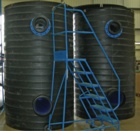Short circuiting the water cycle

As rainwater harvesting enjoys increasing popularity, building-services professionals should
look more closely at the subject than they have done previously, says Darren Crane.
Rainwater harvesting has always had a potential that is undeniable. Now it is set to become an increasingly significant part of the modern built environment.
If proof is needed, take a look at some of the facts surrounding the UK’s water issues. While Italy and Spain have an average water-supply capacity of 2785 m3 per person, England and Wales have just 1334 m3. In areas of high population density there is even less water available per person.
With up to 80% of the water in non-domestic buildings used for non-potable applications, much of this demand can be met by recycling rainwater— something we are not short of. Average UK temperatures are predicted to rise by up to 3.5 K over the next 70 years, bringing changing rainfall patterns and wetter winters. Rather than simply wasting this extra rainwater, recycling it for toilet flushing, vehicle washing and irrigation purposes will ease the demand on our vital mains supplies.
Standard systems?
So if recycling rainwater can help tackle our water problems, it is tempting to ask what sort of system is suited to the average building? While ‘off-the-shelf’ solutions are available for domestic purposes, there is no such thing as a typical system for commercial premises. There are many system components available which need to be brought together carefully to create a bespoke solution for each project. That
is why it is always best to deal with a proven manufacturer which can provide all the components and technical advice you are likely to need.
The basic system components include a pre-filter
to remove debris during collection, a storage tank, a second-stage filtration and pump assembly and a control module to manage the process. Extra filtration can be added if required, as can disinfection units to kill bacteria. Let us look at some of these in a little more detail.
Above and below
The storage unit can be installed below ground or above.
The below-ground option hides the system from view and can be useful where surface space is limited. It also helps protect the
water from fluctuating temperatures, which can aid the growth of bacteria. GRP tanks are typically available in capacities from 1500
to 300 000 litres. Different types of tank can be buried at different depths, so various types of
conditions on site can be accommodated.

In contrast, above-ground sectional GRP tanks can be used where tanks are required to be sited internally, usually in a plant room. Their sectional construction allows them to be constructed within confined spaces for applications where a buried tank is not considered viable.
Operating under pressure
The two types of operating system for rainwater harvesting are gravity and pressure, with the nature of each application having a great influence on which is specified
A gravity system will pump water from the primary storage tank to a header tank at high level in the building being served. It is then distributed, via gravity, to the point of use. Water levels are monitored so that if harvested rainwater is not available, fresh mains water can be supplied to the header tank to ensure the system does not run dry. Available with either a single pump or with a standby unit as well, gravity systems are suitable for a wide variety of applications.
The pressure-operated system has no header tank. Instead, the system monitors the demand for water and pumps it directly from the main storage tank to the appropriate outlet. Water levels in the main storage tank are again monitored to prevent the system running dry. In addition, advanced control units are also available to deliver harvested rainwater under pressure. These units typically house a 200 litre break tank, complete
with an ‘AA’ air gap (to ensure compliance with regulations) and a set of duty/standby pumps. These can also be used to deliver water directly to the appliances, while mains water top-up is directed to the internal break tank, rather than directly to the underground tank. By eliminating the header tank these pressure systems can save space inside the building and will provide water at a greater pressure than a gravity system.
Again, both single and duty standby versions are available, increasing the range of possible applications.
The bigger picture
As effective as rainwater harvesting is alone, it can also be used as a component within larger SUDs (sustainable drainage system) water-management systems and can form an
integral part of a wider ‘roof-to-river’ water-management strategy.
While rainwater harvesting can help conserve one of our most vital resources, one last factor is driving its popularity more than any other — legislation. The growing profile of water issues has generated a large body of legislation and guidelines which are becoming increasing stringent as time passes. BREEAM, Building Regulations, the Code for Sustainable Homes and many other initiatives are increasing the demand for rainwater re-use — and that means that building-services professionals need to look far more closely at the subject than they might have done before.
Darren Crane is national sales manager for rainwater harvesting with Polypipe Rainstream
www.polypipe.com









